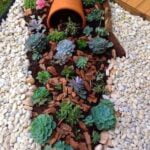Are you looking for the best vegetable gardening ideas to start your own homegrown produce? Vegetable gardening is a rewarding and fulfilling hobby that allows you to enjoy fresh and healthy vegetables right from your own backyard.
In this article, we will explore the essential aspects of vegetable gardening, from choosing the right location and planning your garden layout to selecting the best vegetables for beginners and maintaining a healthy, pest-free garden. Whether you are a seasoned gardener or just getting started, these ideas will help you create a productive and sustainable vegetable garden.
When it comes to vegetable gardening, one of the most important considerations is choosing the right location for your garden. The success of your garden largely depends on factors such as sunlight, water drainage, and soil quality.
We will discuss how to select the perfect spot for your vegetable garden to ensure optimal growth and yield of your plants. Additionally, we will cover the essential tools and supplies needed for successful vegetable gardening, as well as creative space-saving ideas for small gardens.
As we delve further into this article, we will provide valuable tips for planning and laying out a productive vegetable garden. From sustainable and eco-friendly practices to harvesting and storing your homegrown vegetables, we will guide you through every step of the vegetable gardening process. Whether you have ample space in your backyard or limited space in an urban setting, our best vegetable gardening ideas will help you embrace the rewards of growing your own produce.
Choosing the Right Location for Your Vegetable Garden
When it comes to starting a vegetable garden, one of the most important decisions you’ll make is choosing the right location for your garden. The success of your garden will largely depend on where you decide to plant it. The best vegetable gardening ideas all start with finding the perfect spot.
Ideally, your vegetable garden should receive at least 6-8 hours of sunlight each day. Look for a location in your yard that gets plenty of direct sunlight, especially in the morning and early afternoon. Vegetables need sunlight to thrive and produce a bountiful harvest, so choosing a sunny spot is crucial for successful gardening.
In addition to sunlight, it’s also important to consider water access when choosing a location for your vegetable garden. Look for an area that is close to a water source or easily accessible with a hose. This will make it much easier to keep your garden properly watered, which is essential for healthy plant growth.
Lastly, consider the soil quality in different areas of your yard. While you can always improve your soil with amendments and compost, starting with good soil can make gardening much easier. Choose an area with well-draining soil that is rich in organic matter for the best results. By carefully selecting the right location for your vegetable garden, you’ll be setting yourself up for a successful growing season.
Essential Tools and Supplies for Successful Vegetable Gardening
When it comes to successful vegetable gardening, having the right tools and supplies is essential for a bountiful harvest. One of the most basic and important tools for any gardener is a durable trowel for planting, digging, and loosening soil. A sturdy garden hose or watering can is also necessary to ensure that your vegetables receive an adequate amount of water. Additionally, a sharp pair of pruning shears will come in handy for trimming and harvesting your crops.
In addition to tools, there are several supplies that are essential for successful vegetable gardening. High-quality soil is perhaps the most important supply you’ll need. Nutrient-rich soil will provide your vegetables with the foundation they need to grow healthy and strong. You’ll also want to invest in organic fertilizer to give your plants an extra boost. Mulch is another valuable supply as it helps retain moisture in the soil, suppresses weeds, and regulates soil temperature.
Lastly, don’t forget about protective gear for yourself. A good pair of gardening gloves will protect your hands from thorns, sharp tools, and dirt. Investing in a wide-brimmed hat and sunscreen will also keep you protected from the sun’s harmful rays during long hours spent in the garden.
Ensuring you have the right tools and supplies on hand not only makes gardening more efficient but also sets you up for success when growing a variety of vegetables. Whether you’re just starting out or looking to revamp your current garden setup, having these essentials will help optimize your vegetable gardening experience and ultimately lead to a better harvest.
Planning and Layout for a Productive Vegetable Garden
When planning and laying out your vegetable garden, there are several factors to consider to ensure its productivity. One of the first things to take into account is the space available for your garden. It’s important to choose a location that receives plenty of sunlight, as most vegetables require at least 6-8 hours of sun per day. Additionally, make sure the area has good soil drainage and access to water for irrigation.
Another important aspect of planning and layout is deciding on the type of garden bed you want to use. Raised beds are a popular choice for vegetable gardening as they provide better drainage, warmer soil, and easier access for planting and harvesting. Traditional in-ground gardening is also an option if you have good soil quality, but it may require more maintenance.
In terms of layout, consider the principles of companion planting, which involves growing certain plants together to maximize their growth and deter pests. For example, planting basil next to tomatoes can improve their flavor and protect against certain insects. Additionally, think about the orientation of your garden beds to optimize sun exposure for each type of vegetable you plan to grow.
| Factor | Consideration |
|---|---|
| Sunlight | Choose a location with at least 6-8 hours of sun per day |
| Drainage | Ensure good soil drainage and access to water for irrigation |
By taking these factors into consideration when planning and laying out your vegetable garden, you’ll be setting yourself up for success in growing a variety of healthy and delicious vegetables right in your own backyard or patio.
Best Vegetables to Grow for Beginners
When starting a vegetable garden, it’s important to choose the right vegetables to grow, especially for beginners. Here are some of the best vegetable options for those just starting out in their gardening journey:
- Tomatoes: One of the most popular choices for beginner gardeners, tomatoes are relatively easy to grow and can be used in a variety of dishes.
- Zucchini: This versatile and prolific vegetable is low-maintenance and produces a bountiful harvest, making it ideal for beginners.
- Green beans: These fast-growing and productive plants are perfect for those new to gardening, as they require minimal care and space.
- Carrots: Carrots are a great choice for beginner gardeners as they can be grown in small spaces and provide a delicious and nutritious yield.
In addition to these vegetables, other excellent options for beginners include lettuce, peppers, and radishes. These vegetables are relatively low maintenance and can thrive in different growing conditions, making them ideal for those who are new to vegetable gardening.
When considering which vegetables to grow as a beginner, it’s essential to research each plant’s specific needs regarding sunlight, water, soil type, and temperature. With proper planning and care, even novice gardeners can enjoy a successful harvest from their homegrown vegetables.
Overall, selecting the right vegetables is crucial when starting a vegetable garden. By choosing low-maintenance and high-yield options like tomatoes, zucchini, green beans, carrots, lettuce, peppers, and radishes, beginners can set themselves up for success in their gardening endeavors.
Tips for Maintaining a Healthy and Pest-Free Vegetable Garden
Maintaining a healthy and pest-free vegetable garden is essential for the success of your gardening endeavors. By following some simple tips and practices, you can ensure that your plants thrive and produce an abundant harvest.
Soil Health and Nutrient Management
One of the key factors in maintaining a healthy vegetable garden is to ensure that the soil is rich in nutrients. Regularly testing the soil for pH levels and nutrient content can help you determine if any amendments are needed. Adding organic matter such as compost, aged manure, or mulch can improve soil structure and fertility, providing essential nutrients for plant growth.
Proper Watering Techniques
Watering your vegetable garden properly is crucial for plant health. Overwatering can lead to root rot and other issues, while underwatering can cause stress and reduced yields. To maintain a healthy garden, it’s important to water at the base of the plants in the early morning or late afternoon to minimize evaporation. Using drip irrigation or soaker hoses can also help deliver water directly to the roots while conserving resources.
Natural Pest Control Methods
To keep pests at bay without resorting to chemical pesticides, consider implementing natural pest control methods in your vegetable garden. Companion planting, which involves growing certain plants together to deter pests or attract beneficial insects, can be effective. Additionally, introducing predator insects such as ladybugs or lacewings can help keep pest populations in check. Regularly inspecting plants for signs of pest damage and addressing issues promptly can also prevent infestations from spreading.
By implementing these strategies, you can maintain a healthy and pest-free vegetable garden, allowing your plants to flourish and providing you with a bountiful harvest of homegrown vegetables.
Creative and Space-Saving Ideas for Small Vegetable Gardens
When it comes to small vegetable gardens, creativity and strategic planning are key to maximizing the space and achieving a bountiful harvest. Limited gardening space shouldn’t deter anyone from growing their own vegetables, as there are numerous innovative ideas to make the most of a compact area. Here are some creative and space-saving ideas for small vegetable gardens:
Vertical Gardening
Vertical gardening is an excellent way to utilize unused vertical space in small gardens. By utilizing trellises, arbors, or wall-mounted planters, you can grow vining vegetables like tomatoes, cucumbers, and beans vertically, saving valuable ground space.
Container Gardening
Containers are ideal for small gardens as they allow flexibility in terms of placement and can be moved around as needed. Utilize pots, window boxes, or hanging baskets to grow a variety of vegetables such as lettuce, peppers, herbs, and even dwarf fruit trees.
Square Foot Gardening
Square foot gardening is a method that involves dividing the growing area into small square sections, typically 1 foot by 1 foot. This technique maximizes planting space while minimizing wasted space between rows. It’s perfect for small gardens and allows for a variety of vegetables to be grown in a compact area.
By incorporating these creative and space-saving ideas into your small vegetable garden, you can make the most of limited space while still enjoying a plentiful harvest of homegrown produce. With some strategic planning and ingenuity, even the smallest of spaces can yield abundance.
Sustainable and Eco-Friendly Practices for Vegetable Gardening
When it comes to vegetable gardening, sustainability and eco-friendliness are key components for success. By incorporating sustainable practices into your gardening routine, you not only reduce your environmental impact but also create a healthier and more vibrant garden. One of the best vegetable gardening ideas is to implement composting.
Composting not only reduces waste by utilizing kitchen scraps and yard waste, but it also creates nutrient-rich soil for your vegetables to thrive in. Additionally, consider using natural pest control methods such as companion planting or introducing beneficial insects to keep pests at bay without the use of harmful chemicals.
Another important sustainable practice for vegetable gardening is water conservation. Consider installing a rain barrel to collect rainwater for watering your garden, or utilizing drip irrigation systems to ensure that water is efficiently delivered directly to the roots of your plants. This not only saves water but also helps prevent soil erosion and runoff.
Furthermore, embracing organic gardening methods is another excellent way to promote sustainability in your vegetable garden. Instead of relying on synthetic fertilizers and pesticides, opt for organic alternatives that nourish the soil and protect your plants without harming the environment.
By focusing on sustainable and eco-friendly practices in your vegetable garden, you can enjoy a bountiful harvest while minimizing your ecological footprint. These best vegetable gardening ideas not only benefit the environment but also contribute to creating a thriving and sustainable garden ecosystem.
Harvesting and Storing Your Homegrown Vegetables
Once you have successfully grown your vegetables, the next step is to harvest and store them properly to ensure that they stay fresh for as long as possible. Here are some essential guidelines for harvesting and storing your homegrown vegetables.
Harvesting Vegetables
When it comes to harvesting, it’s crucial to know the right time to pick your vegetables. Each type of vegetable has its own specific harvesting time, so it’s important to do some research or consult with experienced gardeners. Generally, vegetables like tomatoes, cucumbers, and peppers should be harvested when they are fully ripe, while leafy greens like lettuce and spinach can be harvested at any time once they have reached a desirable size.
Storing Vegetables
After harvesting, proper storage is key to keeping your vegetables fresh. Some vegetables like carrots, potatoes, and onions can be stored in a cool, dark place such as a root cellar or a basement.
Others may require refrigeration to maintain freshness. It’s important to store vegetables in the right conditions – for example, do not wash produce like mushrooms or berries until you’re ready to use them, and avoid storing fruits like apples near other produce as they release ethylene gas which can cause spoilage.
Pickling and Canning
For an extended shelf life of your homegrown vegetables, consider pickling or canning them. Pickling involves preserving vegetables in vinegar or brine, while canning uses heat to seal jars containing the produce. Both methods are great ways to enjoy your harvest throughout the year and make excellent additions to meals.
Now that you have learned how to harvest and store your homegrown veggies effectively, you can enjoy the fruits of your labor for months after the growing season has ended. The best vegetable gardening ideas include not only successful growth but also proper harvesting and storage techniques for long-lasting enjoyment of fresh produce from your own garden.
Conclusion
In conclusion, vegetable gardening offers a plethora of benefits for both the mind and body. Not only does it provide a source of fresh, organic produce, but it also promotes physical activity and mental well-being. By embracing the best vegetable gardening ideas presented in this article, individuals can create thriving gardens that yield a bountiful harvest while enjoying the many rewards that come with it.
From choosing the right location and essential tools to planning and layout, there are numerous factors that contribute to successful vegetable gardening. Implementing sustainable and eco-friendly practices not only benefits the environment but also ensures a healthier yield. Additionally, smaller spaces should not deter anyone from enjoying a vegetable garden, as there are creative and space-saving ideas that can be employed to maximize productivity.
As beginners start their journey into vegetable gardening, they will find that nothing compares to the satisfaction of harvesting homegrown vegetables. The process of cultivating and nurturing plants instills a sense of pride and accomplishment. Moreover, having access to fresh produce right at one’s fingertips is immensely gratifying and promotes a healthier lifestyle. With dedication, patience, and the implementation of best practices, every gardener can enjoy the rewards of their labor in due time.

Welcome to my gardening blog! I am passionate about plants and enjoy sharing my knowledge and experiences with others. In this blog, I will write about everything related to gardening, from tips on how to get started to updates on my own garden projects.





